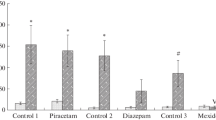Abstract
Dissociated Learning was demonstrated and disrupted in a modified T-maze escape learning task, using male hooded rats. The Dissociation group was trained each day to run in one direction while in the D state (Librium, 15mg/kg) and in the poposite direction when in the ND (sterile water) state. For the Transfer group, a 10 kHz tone was paired with foot shock during training in the D state, and 1 kHz tone was paired with foot shock in the ND state. Dissociated responding occurred in non-shock testing sessions for the Dissociation group. The tone-drug state pairings were reversed during testing for the Transfer group, and these Ss turned in the direction signalled by the tone as often as Dissociation Ss turned in the drug state direction (p<0.01). The tones acquired the aversive-motivational characteristics of foot shock and disrupted dissociated learning by mediating transfer between drug states.
Similar content being viewed by others
References
Bindra, D., Reichert, H.: Dissociation of movement initiation without dissociation of response choice. Psychonom. Sci. 4, 95–96 (1966).
Brown, A., Feldman, R. S., Moore, J. W.: Conditional discrimination learning based upon chlordiazepoxide: Dissociation or cue? J. comp. physiol. Psychol. 66, 211–215 (1968).
Dixon, W. J., Massey, F. J.: Introduction to statistical analysis. New York: McGraw-Hill 1957.
Hill, H. E., Jones, B. E., Bell, E. C.: State dependent control of discrimination by morphine and pentobarbital. Psychopharmacologia (Berl.) 22, 305–313 (1971).
Iawahara, S., Matsushita, K.: Effects of drug-state changes upon black-white discrimination learning in rats. Psychopharmacologia (Berl.) 19, 347–358 (1971).
Overton, D. A.: Discriminative control of behavior by drug states. In: Thompson and Pickens (eds.): Stimulus property of drugs. New York: Appleton-Century Crofts 1971.
Overton, D. A.: State-dependent or “dissociated” learning produced with pentobarbital. J. comp. physiol. Psychol. 57, 3–12 (1964).
Sachs, E., Weingarten, M., Klein, N. W., Jr.: Effects of chlordiazepoxide on the acquisition of avoidance learning and its transfer to the normal state and other drug conditions. Psychopharmacologia (Berl.) 9, 17–30 (1966).
Winer, B. J.: Statistical principles in experimental design. New York: McGraw-Hill 1962.
Author information
Authors and Affiliations
Rights and permissions
About this article
Cite this article
Connelly, J.F., Connelly, J.M. & Epps, J.O. Disruption of Dissociated Learning in a Discrimination paradigm by emotionally-important stimuli. Psychopharmacologia 30, 275–282 (1973). https://doi.org/10.1007/BF00422874
Received:
Revised:
Issue Date:
DOI: https://doi.org/10.1007/BF00422874




